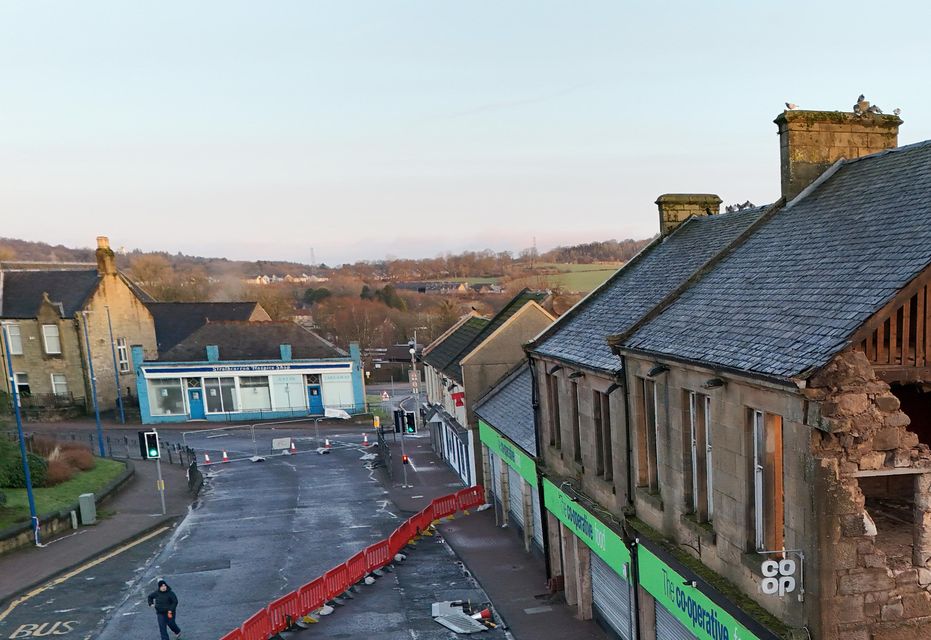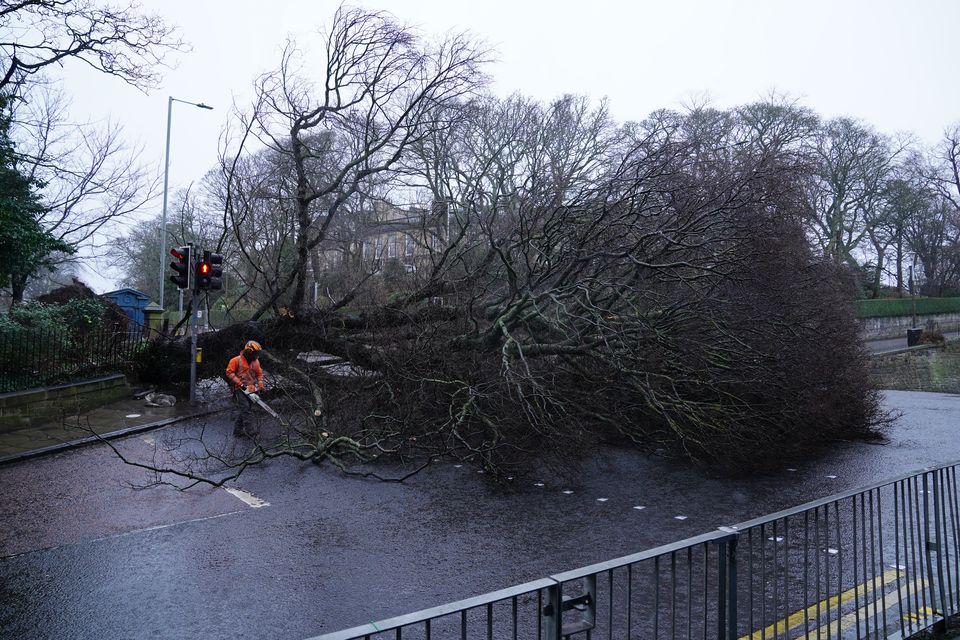Disruption is continuing after Storm Eowyn battered Scotland, claiming one life and leaving thousands without power.
On Sunday evening around 16,000 properties were still without electricity as power companies worked to restore supplies after the storm on Friday.
The high winds also caused significant damage to infrastructure on the rail network and Network Rail is working on repairs, with lines opening when safe to do so.
The Co-op store in Denny, Stirlingshire, was damaged in the storm (Andrew Milligan/PA)
ScotRail communications director David Ross said it had been a “very challenging” weekend but the “vast majority” of routes are back up and running.
He told BBC Radio Scotland’s Good Morning Scotland programme: “A lot of work has been carried out over the course of the weekend by colleagues at Network Rail.
“They’ve had reports of around 500 individual incidents and more than 120 trees fallen down on to the lines, so that’s been a massive repair job.
“So, as I say, the vast majority of routes are up and running, but there is still ongoing disruption in some parts of the country, for example, in Ayrshire and Inverclyde we’re still seeing some impacts – damaged overhead wires, for example.
“We’re still also seeing trees fallen on to the lines and on to the railway in some parts of the country, some areas of Lanarkshire. So the impact of the storm is still being felt.”
We need your consent to load this Social Media content. We use a number of different Social Media outlets to manage extra content that can set cookies on your device and collect data about your activity.
Mr Ross said that in some parts of the country there will not be a “quick fix” and the impact may be felt for several days.
“There’s a lot of work involved in areas particularly where the wires have come down entirely – that is not a quick fix,” he said.
“So there are some parts of the country, for example down at Balloch, that will take a few days, it’s not going to be sorted quickly.”
He advised people to check the ScotRail website and app before travelling.
On Friday, hundreds of schools around the country were shut, with weather warnings in place across the country.
These included a red danger to life warning between 10am and 5pm that day, which covered the central belt and Dumfries and Galloway and stretched north on the west coast to Jura in Argyll and Bute.
Workers have been removing fallen trees in Edinburgh (Jane Barlow/PA)
While most schools are expected to reopen after the weekend, damage to some buildings will mean at least 20 will remain closed until repairs are made, the Scottish Government said.
A 19-year-old man died when his car was hit by a falling tree in Mauchline, East Ayrshire, at around 6.45am on Friday before the red weather warning came into force.
He was taken to the Queen Elizabeth University Hospital in Glasgow and died on Saturday, police said.
Speaking after a meeting of the Scottish Government’s Resilience Room (SGORR) on Sunday evening, First Minister John Swinney said: “I want to thank those working in the public, private and third sector who continue to work tirelessly in difficult conditions to get Scotland fully back on its feet following this extremely serious storm.
“I also appreciate the continued patience of the public while this work continues, and encourage them to take extra care and look out for each other, particularly those who are supporting vulnerable neighbours and family members.
“The severity of the damage caused by this major event has had a considerable impact across a wide area of the country. While every effort has been made over the weekend to fully restore services, unfortunately it is clear some disruption can continue to be expected.”
We need your consent to load this Social Media content. We use a number of different Social Media outlets to manage extra content that can set cookies on your device and collect data about your activity.
A number of public spaces and parks have also experienced extensive damage.
The Royal Botanic Garden Edinburgh said the storm caused “severe damage” across its gardens.
In a post on social media, it said: “At Edinburgh, 15 trees have been lost – either uprooted or damaged beyond recovery.
“This includes the garden’s tallest tree, the 29-metre Cedrus deodara, planted in 1859.”

